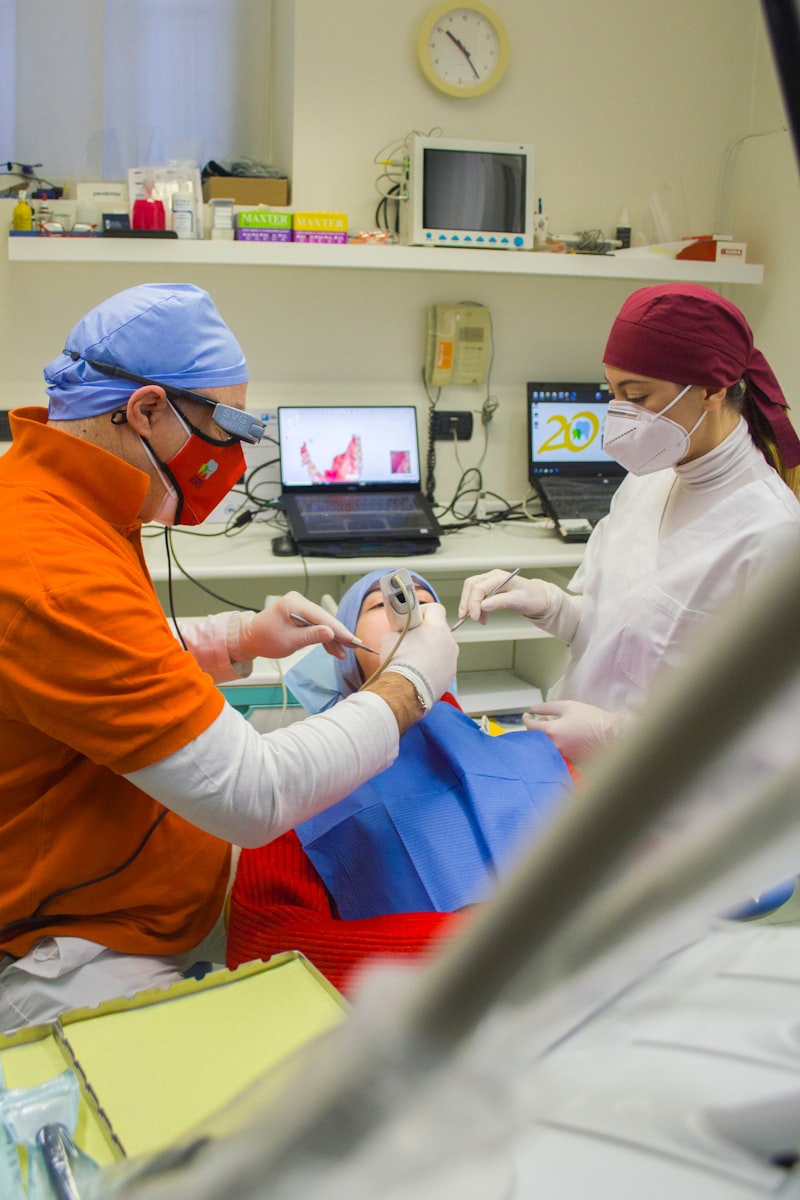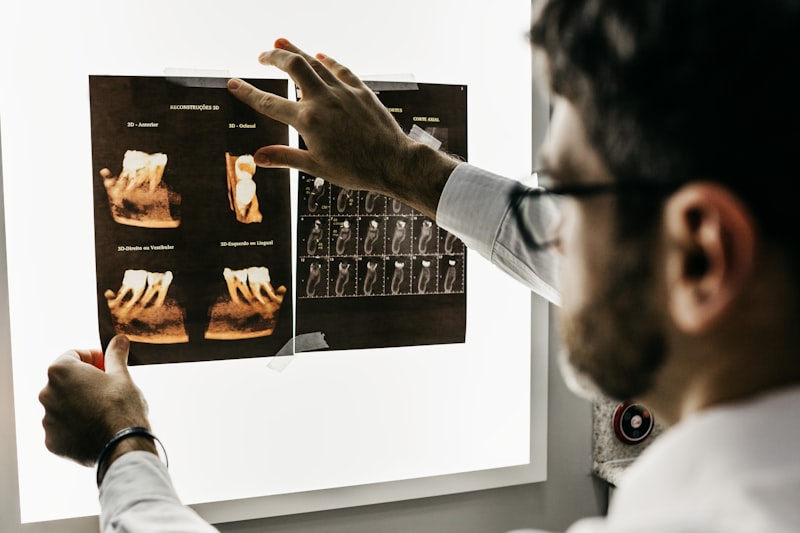Dental x-rays play a crucial role in diagnosing oral health issues that aren’t visible to the naked eye. These images provide dentists with valuable insights into the condition of teeth, gums, and underlying bone structures. There are several types of dental x-rays, each serving specific purposes based on the information needed.
Firstly, bitewing x-rays focus on the crowns of the upper and lower teeth. They help detect decay between teeth and assess bone density changes caused by gum disease. These x-rays are especially useful for monitoring the progression of dental problems over time.
Secondly, periapical x-rays capture the entire tooth from crown to root. They reveal details of the tooth’s root structure and surrounding bone, aiding in diagnosing infections, impacted teeth, and bone abnormalities. Dentists use periapical x-rays to plan treatments such as root canals or tooth extractions.
Panoramic x-rays, on the other hand, provide a broad view of the entire mouth. They show all the teeth, upper and lower jaws, sinuses, and temporomandibular joints in a single image. This type of x-ray is invaluable for detecting impacted teeth, fractures, tumors, and jaw disorders. It is often used for comprehensive treatment planning, especially for orthodontic and surgical procedures.
For more detailed images of specific areas, occlusal x-rays are employed. These x-rays focus on a specific section of the mouth, providing close-up views that highlight issues like cysts, growths, or abnormalities in the floor of the mouth or palate. They are useful in pediatric dentistry and for identifying foreign objects lodged in the oral cavity.
Lastly, cone beam computed tomography (CBCT) represents the latest advancement in dental imaging technology. It produces 3D images of teeth, soft tissues, nerve pathways, and bone in a single scan. CBCT is particularly beneficial for complex dental procedures such as implant placement, orthognathic surgery, and diagnosing TMJ disorders.
Understanding the different types of dental x-rays empowers patients to discuss their oral health concerns with their dentist effectively. By utilizing these imaging tools strategically, dental professionals can provide accurate diagnoses and tailored treatment plans, ensuring optimal oral health outcomes for every patient.
Decoding Dental Imaging: A Guide to Different Types of X-Rays
When it comes to dental care, understanding the role of X-rays is crucial for both patients and practitioners alike. Dental X-rays, also known as radiographs, play a vital role in diagnosing oral health issues that may not be visible during a regular dental exam. They provide a detailed view of the teeth, gums, and bones surrounding the mouth, aiding dentists in making accurate diagnoses and creating effective treatment plans.
There are several types of dental X-rays, each serving a specific purpose in dental diagnostics. One of the most common types is the bitewing X-ray, which captures images of the upper and lower teeth in one area of the mouth. These X-rays are particularly useful for detecting cavities between teeth and assessing the health of the bone supporting the teeth.
Another type is the panoramic X-ray, which gives a broad view of the entire mouth, including the jawbone and joints. This type of X-ray is invaluable for planning orthodontic treatment, evaluating impacted teeth, and detecting tumors or cysts in the jaw.
For more detailed images of specific teeth and roots, dentists use periapical X-rays. These focus on one or two teeth at a time, showing the entire length of each tooth from crown to root tip. They are essential for diagnosing root infections, monitoring dental work, and assessing trauma to the teeth.
Cone beam computed tomography (CBCT) is a specialized type of X-ray that provides a three-dimensional view of the teeth and surrounding structures. It offers precise images with minimal radiation exposure, making it ideal for complex dental procedures such as dental implant placement and orthognathic surgery.
Understanding the different types of dental X-rays empowers patients to actively participate in their dental care decisions. By discussing the benefits and risks of each type of X-ray with their dentist, patients can make informed choices that contribute to their overall oral health.
Dental X-rays are invaluable tools that help dentists diagnose and treat oral health issues effectively. By utilizing various types of X-rays, dental professionals can provide comprehensive care tailored to each patient’s needs, ensuring optimal dental health outcomes.
Comprehensive Overview: Types of Dental X-Rays Explained
Dental x-rays play a crucial role in modern dentistry, allowing dentists to see beyond what’s visible to the naked eye. There are several types of dental x-rays, each serving a unique purpose in diagnosing oral health issues. Understanding these types can help patients feel more informed during dental visits.
1. Bitewing X-Rays: These x-rays focus on the upper and lower back teeth. They are commonly used to detect cavities and monitor the health of bone levels surrounding the teeth. Bitewing x-rays are particularly useful in identifying early signs of decay between teeth.
2. Periapical X-Rays: Periapical x-rays capture the entire tooth from the crown to the root. They are essential for identifying problems in the root structure, such as infections or bone loss. Dentists use periapical x-rays to assess the overall health of individual teeth.
3. Panoramic X-Rays: Also known as panoramic radiographs, these x-rays provide a broad view of the entire mouth. They capture the teeth, jaws, and surrounding structures in a single image. Panoramic x-rays are useful for evaluating wisdom teeth, planning orthodontic treatment, and detecting abnormalities like tumors.
4. Occlusal X-Rays: These x-rays focus on the floor or roof of the mouth and are primarily used to locate extra teeth, assess the development of permanent teeth in children, or identify cysts.

Each type of dental x-ray serves a specific diagnostic purpose, helping dentists to provide accurate treatment plans tailored to each patient’s oral health needs. By understanding these x-ray types, patients can actively participate in discussions about their dental care and make informed decisions about their treatment options.

This article aims to inform readers about the various types of dental x-rays and their significance in dental diagnostics, encouraging engagement and understanding among patients regarding their oral health care.
Peek Inside Your Smile: Demystifying Dental X-Ray Varieties
First up, we have the bitewing X-rays. These are probably the ones you’re most familiar with—they capture images of your molars and premolars. They help your dentist spot cavities forming between your teeth, a tricky spot to see with just the naked eye.
Then there’s the periapical X-ray, which focuses on just one or two teeth at a time. It’s ideal for pinpointing specific dental issues like root problems or detecting abnormalities in the bone surrounding your teeth.
Ever wondered what’s happening beneath your gums? That’s where the panoramic X-ray comes into play. It gives your dentist a wide view of your entire mouth, including your jawbone and all your teeth. It’s perfect for planning treatments like braces or assessing the growth of wisdom teeth.
For those moments when your dentist needs to see the intricate details of a specific tooth’s roots, they might use a cone beam computed tomography (CBCT) scan. This type of X-ray provides a 3D view of your teeth and surrounding structures, offering detailed information for precise diagnoses and treatment planning.
Lastly, there’s the digital X-ray, a modern twist on traditional film X-rays. It reduces radiation exposure significantly and allows for instant viewing on a computer screen, making it both convenient and eco-friendly.
Next time you’re at the dentist’s office and they suggest taking an X-ray, you’ll know exactly what they’re talking about. These different types of dental X-rays ensure that your smile stays healthy and your teeth stay strong, all while keeping you informed about your dental care every step of the way.
Your Dental Checkup: What You Need to Know About X-Ray Options
When you visit your dentist for a checkup, they may recommend taking X-rays to get a comprehensive view of your teeth, gums, and jawbone. These images help dentists detect problems such as cavities between teeth, infections, gum disease, and even tumors. By identifying these issues early on, dentists can provide timely treatment, preventing further complications.
There are different types of dental X-rays, each serving specific purposes based on what the dentist needs to examine:
-
Bitewing X-rays: These X-rays capture the upper and lower back teeth in a single image. They are useful for detecting decay between teeth and assessing the fit of dental fillings.
-
Periapical X-rays: These focus on one or two teeth at a time, showing the entire length of each tooth from crown to root. Dentists use them to detect abscesses, root infections, and bone changes around the tooth.
-
Panoramic X-rays: This type provides a broad view of the entire mouth, including all teeth, upper and lower jaws, and surrounding structures. It helps in planning orthodontic treatment, assessing wisdom teeth, and detecting jaw problems.
-
Occlusal X-rays: These show a broad view of the floor of the mouth, particularly useful in detecting issues with the floor of the mouth and palate.
Before taking X-rays, your dentist will consider factors such as your age, dental history, and symptoms to determine which type is most appropriate. They prioritize minimizing radiation exposure by using techniques such as lead aprons and digital X-rays, which reduce radiation levels significantly compared to traditional film X-rays.
Understanding the importance of dental X-rays and their role in preventive care empowers you to make informed decisions about your oral health. By following your dentist’s recommendations for regular checkups and X-rays, you contribute to maintaining a healthy smile for years to come.
X-Rays at the Dentist: Understanding Variations for Better Oral Health
In modern dental practice, intraoral X-rays are commonly used to detect cavities, check the health of the tooth root and bone surrounding the tooth, and monitor the general health of teeth and jaws over time. These X-rays are taken from inside the mouth and provide high-definition images that help dentists pinpoint issues early on, preventing potential complications.
On the other hand, extraoral X-rays capture a broader view of the entire mouth, jaw, and skull. This type of imaging is useful for monitoring overall jaw and teeth development, assessing impacted teeth, and diagnosing temporomandibular joint (TMJ) disorders. It offers a comprehensive view that aids in planning orthodontic treatment and oral surgeries.
Panoramic X-rays are a standout in dental imaging, providing a complete view of the mouth in a single image. They are particularly useful for assessing wisdom teeth, detecting tumors and cysts, and evaluating the relationship between teeth and jaws. This panoramic view assists dentists in making informed decisions about treatments, ensuring comprehensive care for their patients.
Cone beam computed tomography (CBCT) represents the latest advancement in dental imaging technology. This 3D imaging technique produces detailed cross-sectional images of the teeth, jawbone, nerve pathways, and soft tissues. It is invaluable for complex procedures such as dental implant placement, orthodontic treatment planning, and evaluating facial fractures.
Understanding these variations in dental X-rays empowers patients to participate actively in their oral health care. By discussing with their dentist the most appropriate type of X-ray for their needs, patients can ensure timely diagnosis and effective treatment, promoting long-term dental health and well-being.
Beyond the Surface: Exploring Various Dental X-Ray Techniques
Firstly, there’s the intraoral X-ray, the cornerstone of dental imaging. It involves placing a sensor inside the mouth to capture detailed images of individual teeth. This technique is invaluable for detecting cavities, monitoring bone health, and assessing tooth roots.
Moving to panoramic X-rays, which provide a comprehensive view of the entire mouth in a single image. Imagine it as a wide-angle snapshot capturing all teeth, upper and lower jaws, and surrounding structures. Dentists rely on this technique for planning treatments like braces or evaluating impacted teeth.
Cone beam computed tomography (CBCT) represents the pinnacle of dental imaging precision. It uses a cone-shaped X-ray beam to create 3D images of teeth, soft tissues, nerve paths, and bone structure. This advanced technology aids in complex dental procedures such as implants, root canal treatments, and surgical planning with unparalleled accuracy.
Beyond these, digital X-rays have revolutionized dental practices by reducing radiation exposure and providing instant images. They are environmentally friendly and allow for easy storage and sharing, enhancing patient care and treatment outcomes.
Each of these techniques offers unique advantages, tailored to different diagnostic needs in dental care. From routine check-ups to intricate surgical procedures, the evolution of dental X-rays continues to elevate standards in oral health management, ensuring precise diagnosis and effective treatment planning.
The diversity of dental X-ray techniques underscores their indispensable role in modern dentistry. They go beyond mere visual inspection, revealing details crucial for maintaining oral health and delivering comprehensive dental care. As technology evolves, so too does our ability to safeguard smiles with clarity and precision.
Frequently Asked Questions
How often should dental X-rays be taken, and why?
Learn about the recommended frequency for dental X-rays and their importance in maintaining oral health.
How do panoramic X-rays differ from bitewing X-rays?
Panoramic X-rays and bitewing X-rays serve different purposes in dental imaging. Panoramic X-rays provide a broad view of the entire mouth, capturing the entire upper and lower jaws in a single image. They are useful for detecting overall dental health, impacted teeth, and jaw disorders. On the other hand, bitewing X-rays focus on specific areas of the mouth, such as the crowns of the upper and lower teeth. They are primarily used to detect cavities and monitor the health of teeth and gums between check-ups.
What are the different types of dental X-rays and their purposes?
Learn about the various types of dental X-rays and their purposes with our concise FAQ. Discover how each type, such as bitewing, periapical, panoramic, and cone beam X-rays, serves specific diagnostic needs in dentistry, from detecting cavities and examining tooth roots to planning orthodontic treatments and assessing jaw structure.
Are dental X-rays safe? What precautions are taken during the procedure?
Learn about the safety of dental X-rays and the precautions taken during the procedure. Understand the measures dental professionals use to minimize radiation exposure, ensuring patient safety.
What can dental X-rays diagnose that a regular dental exam cannot?
Dental X-rays can diagnose issues such as hidden cavities, bone infections, impacted teeth, and jawbone damage that may not be visible during a regular dental exam. They provide detailed images to help dentists detect problems early and plan appropriate treatments.



